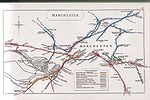St Luke's Church, Pendleton
19th-century Church of England church buildingsChurch of England church buildings in Greater ManchesterChurches in SalfordGrade II* listed churches in Greater ManchesterStructures on the Heritage at Risk register

St Luke's Church is an Anglican church that stands on raised ground in Liverpool Street, Pendleton, Salford. The church, in the parish of Weaste, Seedley and Langworthy, is part of the Salford All Saints Team Ministry in the Salford deanery and the Manchester diocese. It was designated as a Grade II* listed building in 1980.
Excerpt from the Wikipedia article St Luke's Church, Pendleton (License: CC BY-SA 3.0, Authors, Images).St Luke's Church, Pendleton
St Luke's Road, Salford Weaste
Geographical coordinates (GPS) Address External links Nearby Places Show on map
Geographical coordinates (GPS)
| Latitude | Longitude |
|---|---|
| N 53.483923 ° | E -2.302661 ° |
Address
Saint Lukes Church
St Luke's Road
M6 5YD Salford, Weaste
England, United Kingdom
Open on Google Maps






